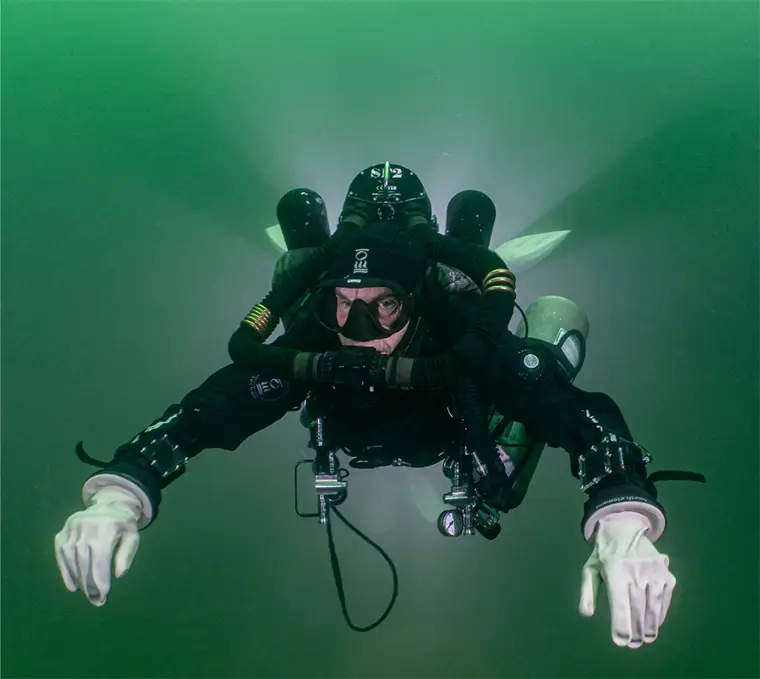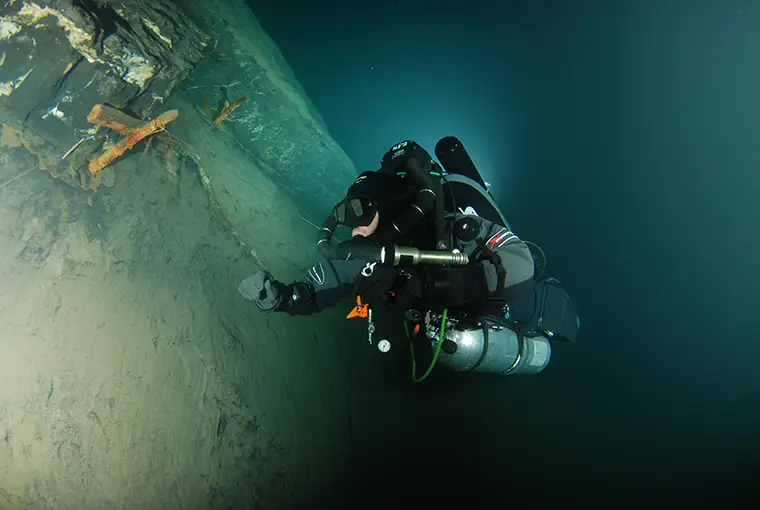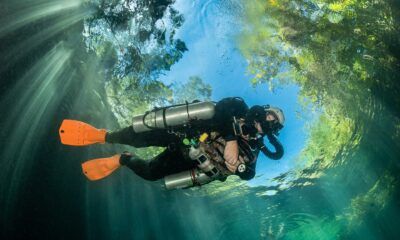Equipment
SF2 – The Good, the Bad, the Beautiful
Instructors Jens O. Meissner and Helmut Spangler discuss diving operations with the SF2 and how it performs in the hands of new inexperienced rebreathers and those diving in the recreational range diving to its performance on 100m/328 ft exploration dives.
by Jens O. Meissner and Helmut Spangler

A diving device is only as good as its user, right? That’s correct. But you can’t get anywhere without usable diving equipment. The SF2 rebreather has been accompanying the 7Oceans Tek team on all kinds of dives to depths of over 100 m/330 ft for over 10 years. Time for a short break to get an overview of the range of applications.
Getting To Know Your SF2: Experiences With The User Course
After dozens of user courses, we can already say that we are able to assess how a new device is put into operation by new, inexperienced users. On the positive side, we have noticed that the entire basic SF2 configuration usually offers a good water position from the first contact with water. Pre-dive setup is simple, and cleaning is done relatively fast. New users quickly internalize the procedures for assembly and checks. And, after the dive, the fact that dismantling and cleaning does not take much time is highly appreciated.
Of course, a few things are different, but this is always the case with CCR diving: the buoyancy control is challenging, the pre-dive sequences and surface checks are more extensive, and they have to be carried out more conscientiously. Even if the device is easy to assemble, it requires discipline, care, and above all, calm and attention during assembly and all checks. Spontaneous dives are not impossible, but they are more challenging. In addition, the field of vision underwater is of course somewhat restricted by the loop. In general, most new users get the impression that after a short time this is a robust device that is very user-friendly and forgives minor—and sometimes more serious—mistakes without immediately becoming a major problem.



Diving In The Recreational Range: Comfort Is Safety
The usual version for most divers is the backmount configuration, in which diluent and oxygen are normally placed in 3-liter cylinders to the left and right of the housing. This variant is user-friendly, as the device is compactly stored on the back and is also easy to operate. In recreational diving, a small bailout cylinder from 40 cubic feet is also very often used, which makes the overall configuration comparatively handy for a rebreather system.
Most safety procedures can be carried out easily by reaching backwards, even if you have to learn how to operate the device safely and store routines in your body memory. Therefore, the biggest challenge for most users is getting into the water regularly with the device.
If you like, you can convert the device to a sidemount configuration, in which the rebreather is carried at the diver’s side, whereas at the other side, a diluent gas is stored which is the bailout bottle at the same time. A small oxygen bottle finds its place at the diver’s lower back. Here, too, operation needs to be learned, but this can be done quickly if you have previous experience in sidemount and rebreather diving. Whether in the caves of Mexico, scootering in the Mediterranean, or in a European quarry pond, the sidemount configuration offers many advantages for reducing the diver’s height and increasing their streamlining. And, with a sidemount setup, the recreational diving area is just the beginning.

Leaving The Known Depths: Getting Ready To Explore
Of course, a rebreather becomes the tool of choice when previous limits are overcome. And, the SF2 makes this possible in an uncomplicated way. The device is configured in the same way as in the recreational setup, only the diluent gas is adjusted in the direction of Helitrox or Trimix, and the bailout gas is adopted accordingly. After training, divers are very quickly on the move with two stages and extra oxygen and can go on a discovery tour. And here lies the next challenge: while equipped very quickly in terms of diving in the Tek Team, the diving destinations and their challenges increase.
Diving from a boat and at unexplored dive sites becomes the norm. And, this also increases the consequences for safety management: more precise calculation of exits and evacuation routes and practicing emergency procedures become increasingly important. Fortunately, the SF2 provides enough leeway for these dives.

On the way back from a wreck exploration at a depth of 75 m/246 ft, for example, we could not see our hands in front of our eyes in the area of the decompression stops at 15, 12 and 9 meters due to the algae bloom and had to increase the safety of the way back over many dives. Without at least three hours of possible dive time due to the rebreather, these activities would have been more uncomfortable. And, when uncertainties add up, a diving accident is no longer a distant prospect.
One more thing about safety: while exploring a tree standing at 50 m/164 ft and taking a wood sample, I suddenly heard a disturbing blowing sound on the left side. My diving partner and I quickly identified the fault—a leak in the diluent supply—and contained it accordingly. We calmly dived out and repaired the source of the leak without any problems. This demonstrates another challenge: the right buddy team can provide the necessary seconds of reaction time at important moments to continue diving safely. Even if you want to gain experience with many partners, stabilizing the buddy team or a core team of like-minded people is an important step if you want to go further and deeper.

Deep Explorations: And There You Go…
For the even more ambitious diver, there is of course no stopping them and deep, long exploration dives need to be mastered. In our case, these are wreck sites to be explored and steep walls beyond 100 m/328 ft. You often don’t immediately find what you’re looking for in the target area. But here, too, the excellent combinability of the system comes into its own. In the lake, we generally use a backmount setup with two stages on the body and two stages in the leash. We also use scooters and underwater camera equipment. With over 100 kg of things to store away, you are naturally reliant on modularity. The stage bottles are transported to the entry point and mounted to the diver at the surface. Under water, parts can be easily clipped over, exchanged or deposited. This makes the SF2 a versatile partner that can take on any challenge.
On our 100+ dives in this depth range, the device has never failed. And the tool is never responsible for a few stupid user errors (let’s talk about it around the campfire…). These are normal given the complexity and preparation intensity of such dives and have more to do with the diving project. When you arrive at the deep exploration point and hear the regular click of the solenoid valve, there is something very reassuring about it, which is certainly helpful at depth. During exploration projects, the easy repair of small things on the device and the very low transport weight when traveling are also very welcome.
And if you want to go even deeper, you can simply configure a second SF2 as a sidemount bailout system. This makes your solution even more redundant and the reserves are even greater. However, here too, every move has to be right, both during installation and in an emergency. But it is a worthwhile investment if you want to be able to fall back on a convenient, emergency solution even on very deep and long dives.

The Good, The Bad, The Beautiful
In over 10 years of experience we faced no serious problems, no severe failures,neither in backmount nor sidemount configurations. As an exploration team, we clock in more than 2500 hours on the device, even more in the larger Tek Team with 30+ tech divers. And the performance record is excellent, be it in European waters, in the Caribbean, in caves everywhere on the planet, and even in ice cold environments. Although you also find other smart solutions and tools for your job, we can recommend the SF2 in lakes, the sea for wreck and cave dives, and we even like it for shallow recreational excursions. For us, it remains the preferred choice, especially for our deep lake explorations.
And, as for “the bad” aspects of the device? Now truly, there are none. There are some things about rebreather diving in general, which could be seen as negative, like high training requirements, the time needed to prepare a dive and clean the setup afterwards, but these issues are not related to the SF2. And, by the way, the whole technical setup with the carbon design of the rebreather tube is just the reason for this article’s title: It is just a beautiful thing. There are many rebreathers out there to do the job. But if you are stuck making a decision between similar options: Always ask yourself about the aesthetics! And, if you consider something as beautiful besides all necessities: Just pick this! And, by the way, the SF2 is a good investment—especially considering its total cost of ownership—not nearly as expensive as other comparable devices.

Jens O. Meissner is a TDI instructor and exploration diver at 7Oceans in Horgen on the Swiss shores of Lake Zurich, a certified scientific diver and lectures organizer and resilience manager at the Lucerne University of Applied Sciences and Arts and Management at the University of St. Gallen. In his research, he focusses on management practices and the necessary “trappings” of technical diving, and he publishes articles and photos in international journals: [email protected]

Helmut Spangler is the owner of the diving center 7Oceans in Horgen on Swiss Lake Zurich and a full-time instructor trainer for TDI Technical Diving International, SSI and several others. He runs the SF2 Service Center Switzerland and issued more than 1,500 certifications and logged more than 7000 dives. Besides diving, he practices martial arts and meditation. He can be reached at: [email protected]



















































